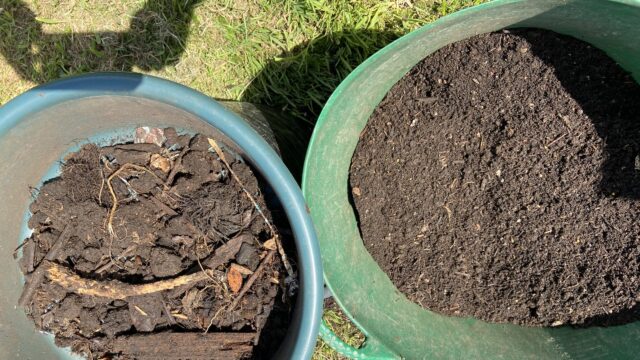The Joy of Compost

The far compost bin is full of rotting kitchen fruit and vegetable peelings and allotment cuttings and clippings. The nearest is emptied and ready to receive the contents of the next door bin.
I last wrote about our vegan organic allotment and how we compost is made two years ago.
It’s time for an update. Besides, any time is a good time to applaud the virtues of compost-making.
We have two purpose-built wooden compost bins side by side on our allotment. Fruit and vegetable waste from our kitchen and the allotment clippings and cuttings fill the right-hand bin. Concurrently, we let the existing plant matter in the left-hand bin rot down over the last year.

Compost ready to be used on the right and the detritus from sieving on the left.
Recently, I emptied the compost from the left-hand bin and spread it around the allotment. I fork out the compost from the bin and drop it into a garden sieve, which I shake from side to side so that the compost falls into a garden bucket. Pure black ‘gold’ compost, moist to the touch and nutrient-rich, adds life to the soil. The stuff left in the sieve (twigs, stones, roots, and other detritus) is tipped into a nearby bank where stinging nettles grow.
The compost is spread around the base of our fruit trees (apple, pear, damson) and among the rhubarb and raspberry bushes. We also prepared a new bed by clearing out the old plants and any weeds, putting down large flattened cardboard boxes to stop the weeds from growing again, and a thick layer of compost on top of that. We placed on top of that a metal fencing panel to prevent the badgers and foxes from digging it up. The cardboard will rot down, and a new crop planted into the bed in the autumn.

Compost on the ground helping the new plants to grow.
The next step is to fork over the rotting plant material from the right to the left-hand bin. We then let this decompose and fill the right-hand bin with new kitchen and allotment plant material. I deliberately use the word material than waste as nothing is wasted in compost making. But now I’m noticing that much of the compost I’m forking over is ready to go as compost onto our allotment beds. So, next time I’m at the allotment, I will continue to sift and place compost onto our raised beds.
Compost-making may not sound much like fun. It’s hard work. You get dirty. But it is immensely satisfying seeing how our apple cores, swede peelings, and allotment clippings transform into life-giving materials that help us grow the fruits and vegetables we eat, thereby keeping the life cycle turning.











